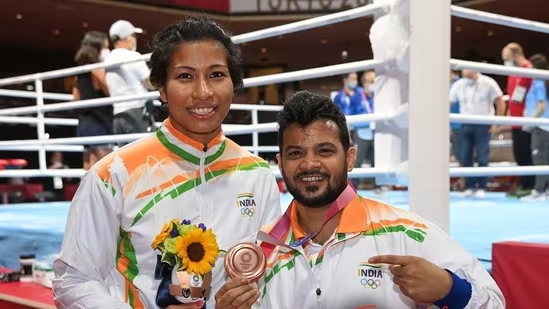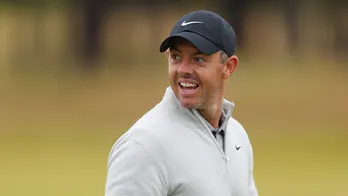How Ali Qamar played a key role in success of India's women's boxers
India's women boxers have stepped up at the international level in the last few years, winning medals from the biggest of stages including world championships and the Olympics. Be it Tokyo Olympics bronze medallist Lovlina Borgohain or reigning world champion Nikhat Zareen, the growing stature of Indian boxers hasn't gone unnoticed.  PREMIUM
PREMIUM
Behind this surge in performance is a strong foundation that was laid at the national camp by the coaching staff. One man who has tirelessly worked behind the scenes towards this goal is Mohammed Ali Qamar, 42, who was the first Indian boxer to win gold at the Commonwealth Games in 2002.
Ali started working with the women’s national team in 2016 and was promoted to head coach of the elite women's team from 2019 -2021. After MC Mary Kom's watershed moment at the London Olympics where she won bronze, India was looking for someone who would step into her shoes and take Indian boxing forward.
Ali recalls a tour of Kazakhstan in 2017 when he saw the boxers fearing to go forward against opponents. “They would mostly rely on counter-punching and they were not attacking enough in all three rounds. I realised that we need to change their mindset and be fearless,” says Ali Qamar.
It was around this time that Zareen and Borgohain were starting to make their mark in the national camp. Zareen, who came to the limelight as a junior world champion in 2011, was known for her technical acumen but she had to sharpen her game from close range.
“She is very good at controlling the fight from long range with good movement of her feet and accuracy of punches. But she was often getting caught in close range and resorting to clinching, unable to score. We worked on her close-range fighting.”
The change in approach saw Zareen win her first major medal at the Asian Championships in 2019 -- a bronze – and she hasn't looked back since.
As for Borgohain, Ali remembers a sparring session when she collided with her opponent as she was trying to scuttle back against a flurry of punches. “Lovlina was a bit fearful when she first came to the national camp. We made her spar with tough opponents. Exposure tours and more competition helped her get rid of that fear.”
Ali, himself a feisty attacking boxer not long ago, was soon made the head coach and together with foreign coach Italian Rafaelle Bergamasco, they formed a good team. Women boxers achieved unprecedented success at the Asian Championships, Worlds, and Olympic qualifiers, leading to Borgohain's historic Tokyo medal.
A complete overhaul of the training regimen was the reason behind the success. Initially, some senior boxers were even displeased with the changes and had to be convinced by the coaches. Gradually things started to fall in place and it showed in the performances at the world level.
"Boxing is a sport that you cannot fight in one rhythm. You need to mix things up... all the time," said Ali Qamar, who was conferred with the Dronacharya Award recently.
"Over time, we realised that our boxers must attack in all three rounds. We had to change because the scoring system was changing often. As a boxer, you didn't know the score until the end of the last round. So, we had to go all out in all three rounds."
"The boxers needed explosive training. We cut down the training time and made it more intense. We wanted to take them to a level when the heartbeat of boxers touched 180 and 190. Raffaele used to say that boxing has become more explosive and we need to train them accordingly," says Qamar.
So, training time was brought down from two and a half hours to one and a half hours but packed with more intensity. There was no breathing space and the speed kept being altered too.
"Suppose there was a 30-minute run after warm-up, earlier kids would do it at the same pace to build endurance. We kept changing the pace from time to time with the blow of a whistle -- sprint, slow, medium. We followed a similar strategy with the bag or shadow punching or sparring and even skipping. We kept changing the pace, asked them to counter for five-six blows. The whole idea was to develop explosive power," says Qamar, who is also an International Boxing Association (IBA) level 3 coach.
Every session was closely monitored and coaches would maintain data on every boxer on how they are coping and where they need to improve. It took around six months for the boxers to adapt and the results started showing.
"The younger lot was quick to adjust to new methods but some seniors felt cutting down on training time might impact their fitness levels and they won't be able to sustain the same energy levels for three rounds. We convinced them that instead, they will benefit. We also asked them to reduce weight gradually before a competition and not wait till the last day. We are still following the same method because it gave us results on the big stage."
The method worked and India won six medals at the 2019 Asian Championships and four at the world championships in Russia. And for the first time, four women boxers qualified for the Olympics. But closer to Tokyo, the pandemic dashed the hopes of a smooth preparation. Almost 21 boxers and coaching staff were infected with COVID in April 2021. It was then a race to regain fitness in a small window.
"We went to the Asian Championships without training for 15 days and their performance was not as per expectations. We realised that we have to cover up for the lost time quickly. The camp was shifted to Pune and the girls were so focused and dedicated that they refused to take even off to visit home saying their training would suffer," reveals Qamar.
Borgohain, infarct, contracted COVID in October 2020 and was constantly monitored as she worked hard to regain her fitness and bring it to a level where she could take on the world's best in Tokyo.
Experience unrestricted digital access with HT Premium
Explore amazing offers on HT + Economist Start 14 Days Free Trial Already Subscribed? Sign In
Disclaimer: The copyright of this article belongs to the original author. Reposting this article is solely for the purpose of information dissemination and does not constitute any investment advice. If there is any infringement, please contact us immediately. We will make corrections or deletions as necessary. Thank you.







